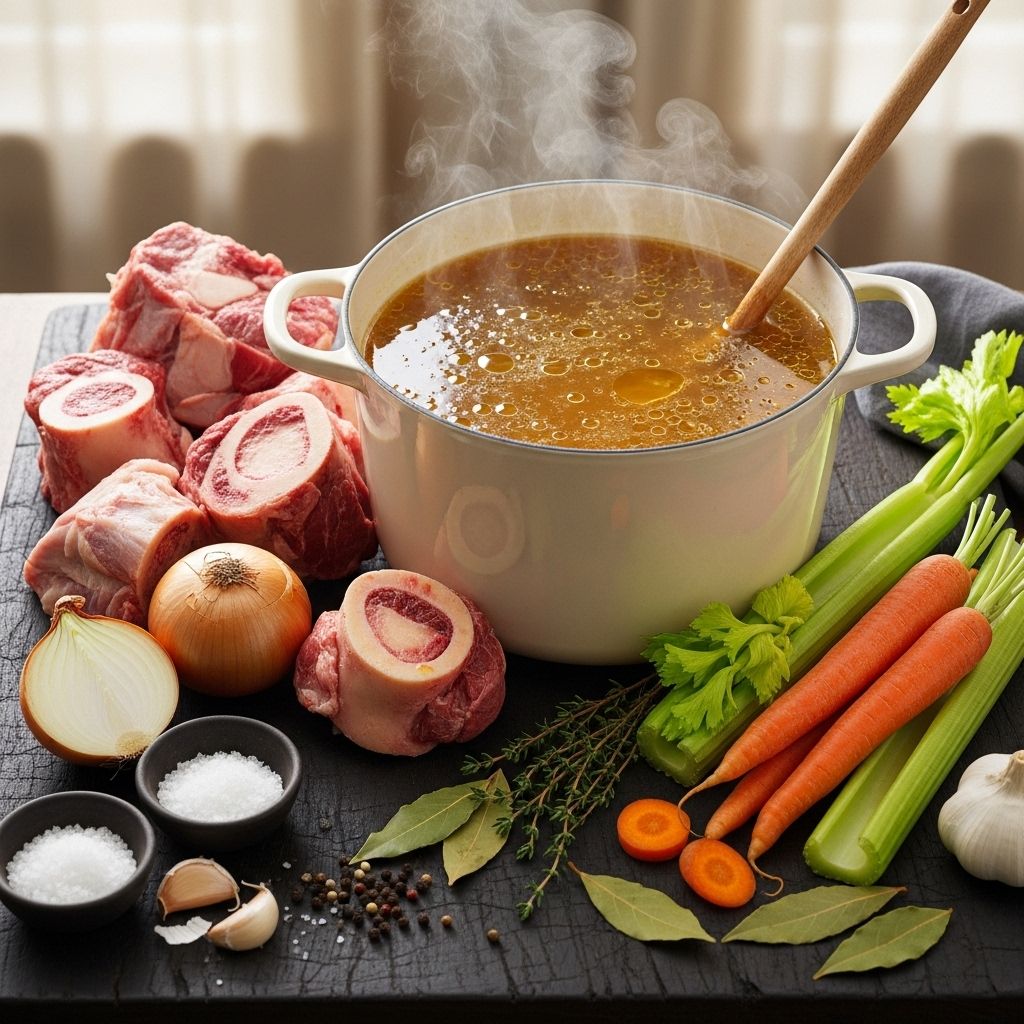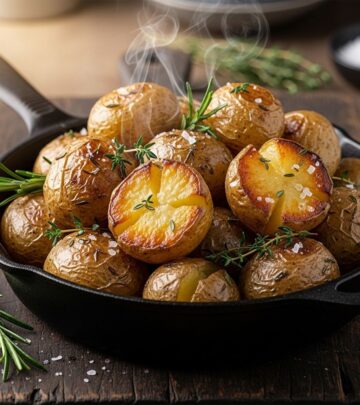Beef Bone Broth Recipe: Ultimate Guide For Nutrient-Rich Broth
Transform beef bones into a rich, flavorful broth that serves as the foundation for countless recipes

Image: HearthJunction Design Team
Ultimate Guide to Making Beef Bone Broth at Home
Beef bone broth has gained immense popularity in recent years, and for good reason. This nutrient-dense liquid is not only the foundation for countless delicious recipes but also offers numerous potential health benefits. Making bone broth at home allows you to control the quality of ingredients while creating a deeply flavorful base for soups, stews, and other culinary creations. This comprehensive guide will walk you through the process of making rich, gelatinous beef bone broth that surpasses anything you can find in stores.
The beauty of homemade beef bone broth lies in its simplicity and depth of flavor. While the process requires time, the actual hands-on work is minimal, making it an ideal weekend cooking project. The resulting broth can be stored and used throughout the week or frozen for future use. Whether you’re looking to enhance your cooking or incorporate more nutrient-rich foods into your diet, mastering beef bone broth is a valuable culinary skill.
Understanding Bone Broth Basics
Before diving into the recipe, it’s important to understand what sets bone broth apart from regular stock. Bone broth is characterized by its long cooking time, which allows for maximum extraction of collagen, minerals, and other nutrients from the bones. This extended simmering breaks down connective tissues, creating a broth that’s rich in gelatin and has a distinctive mouthfeel.
The foundation of excellent bone broth begins with selecting high-quality bones. Ideally, source grass-fed, organic beef bones when possible. The variety of bones used significantly impacts the final product. A combination of marrow-rich bones (like femur), joint bones (like knuckles), and meaty bones (like short ribs or oxtail) creates the most balanced flavor profile and nutritional content.
Essential Ingredients for Beef Bone Broth
Creating a flavorful beef bone broth requires relatively few ingredients, but each plays an important role in developing depth of flavor. Here’s what you’ll need for this recipe:
- 3 ½ pounds beef bones (a mix of oxtail, short rib, knuckle, and shank)
- 2 stalks celery, cut into 2-inch pieces
- 1 large onion, cut into 8 pieces
- 1 medium leek – roots trimmed off, cleaned, and cut into 2-inch pieces
- 1 whole head garlic, halved crosswise
- 12 cups water, or as needed
- 2 bay leaves, or more to taste
- 1 tablespoon white vinegar
- 1 teaspoon salt
- 1 teaspoon ground black pepper
The vegetables add aromatics and depth to the broth, while the vinegar plays a crucial role in helping to extract minerals from the bones. Feel free to adjust the seasonings to your taste preferences, but keep in mind that bone broth often serves as a base for other recipes, so a neutral, well-balanced flavor is ideal.
Step-by-Step Preparation Method
Roasting the Bones
The first critical step in making exceptional bone broth is roasting the bones. This process caramelizes the surface of the bones and any attached meat, developing rich, deep flavors that will transfer to your broth.
Begin by preheating your oven to 450 degrees F (230 degrees C). Line a baking sheet with aluminum foil for easier cleanup, then arrange your beef bones in a single layer on the prepared sheet. Place the bones in the preheated oven and roast them for approximately 40 minutes. For even browning, turn the bones over at the halfway point, about 20 minutes into roasting.
You’ll know the bones are properly roasted when they’ve developed a deep brown color and a rich, savory aroma fills your kitchen. Avoid burning the bones, as this can introduce bitter flavors to your broth.
Building the Broth Base
Once your bones are beautifully roasted, it’s time to build the foundation of your broth. Carefully transfer the hot bones into a large stockpot, making sure to pour in any juices that collected on the baking sheet. These drippings contain concentrated flavor that will enhance your broth.
Next, add your aromatic vegetables – celery, onion, leek, and garlic – to the stockpot with the bones. These vegetables will impart essential flavors while also providing additional nutrients. Pour in just enough water to completely cover the bones and vegetables, approximately 12 cups, though you may need more or less depending on the size of your pot.
Season the mixture with bay leaves, white vinegar, salt, and pepper. The vinegar is particularly important as it helps to extract minerals from the bones during the cooking process, increasing both the nutritional value and the body of your broth.
The Slow Simmering Process
Proper simmering is where the magic happens in bone broth making. Place your pot over medium-high heat and bring the mixture to a boil. Once boiling, immediately reduce the heat to maintain a very low simmer. You want to see just a few bubbles breaking the surface – a gentle, not vigorous, simmer.
Cover the pot, but leave the lid slightly vented to allow for some evaporation. This helps concentrate the broth over time. Now comes the waiting game – allow your broth to simmer for approximately 12 hours. This extended cooking time is what sets bone broth apart from regular stock, allowing for maximum extraction of nutrients, collagen, and flavor.
During the simmering period, occasionally check on your broth. Skim off any foam or impurities that rise to the surface using a fine-mesh skimmer or spoon. This step ensures a clearer, cleaner-tasting final product. Additionally, monitor the water level and add more as needed to keep the bones and vegetables submerged throughout the cooking process.
Straining and Storing Your Broth
After the long simmering period, your kitchen will be filled with an incredible aroma, and your broth will have transformed into a rich, flavorful liquid. The next step is to strain the broth to remove all solids.
Set a large bowl or another pot in your sink and position a fine-mesh strainer over it. Carefully pour the broth through the strainer, allowing the liquid to pass through while catching all the bones and vegetables. For an even clearer broth, you can line the strainer with cheesecloth.
Allow the strained broth to cool slightly, then transfer it to storage containers. If you plan to use the broth within a week, refrigeration is sufficient. For longer storage, freezing is the best option. Consider using ice cube trays or small containers for freezing portions that can be easily added to recipes as needed.
When properly chilled, a good bone broth will develop a layer of fat on top, which you can either remove or stir back in, depending on your preference and intended use. The broth should also have a gelatinous consistency when cold – this is a sign of successful collagen extraction and indicates a nutrient-rich broth.
Nutritional Benefits and Uses
Bone broth is celebrated for its potential nutritional benefits. Rich in collagen, which breaks down into gelatin during cooking, bone broth may support joint health and digestion. It also contains minerals like calcium, magnesium, and phosphorus, as well as amino acids that the body uses for various functions.
The versatility of beef bone broth makes it a valuable addition to your culinary repertoire. Use it as a base for soups and stews, for cooking grains, or simply enjoy it on its own as a warming, nourishing beverage. Some people incorporate bone broth into their daily routine, sipping it from a mug with a pinch of salt or additional seasonings.
Recipe Variations and Customizations
While this basic beef bone broth recipe provides an excellent foundation, there are numerous ways to customize it based on your preferences and intended use:
- Herbs and Spices: Add fresh herbs like thyme, rosemary, or parsley during the last hour of simmering for additional flavor.
- Asian-Inspired: Include ginger, star anise, and cinnamon for a broth that works beautifully in pho or other Asian soups.
- Vegetable Variations: Experiment with different aromatic vegetables like carrots, parsnips, or mushroom stems.
- Concentrated Version: After straining, return the broth to the pot and simmer until reduced by half for a more intense flavor that takes up less storage space.
Remember that bone broth is as much an art as it is a science. Feel free to adjust and experiment based on your taste preferences and the ingredients you have available.
Frequently Asked Questions
Q: Why is my bone broth not gelatinous after cooling?
A: This usually indicates that either there weren’t enough collagen-rich bones (like knuckles and feet) in your mix, or the broth was cooked at too high a temperature. Maintain a very gentle simmer and ensure you’re using a variety of bones, including joints.
Q: Can I make bone broth in a slow cooker or pressure cooker?
A: Absolutely! A slow cooker works wonderfully for bone broth – set it to low for 24-48 hours. Pressure cookers (like Instant Pots) can dramatically reduce cooking time to about 2-3 hours while still extracting nutrients effectively.
Q: How can I tell if my bone broth has gone bad?
A: Trust your senses. If the broth develops an off odor, unusual color, or moldy appearance, it should be discarded. Properly stored, bone broth typically lasts 5-7 days in the refrigerator or up to 6 months in the freezer.
Q: Is it normal for bone broth to have a layer of fat on top?
A: Yes, this is completely normal and can actually help preserve the broth by creating a seal. You can skim it off before using the broth or leave it in for added richness and flavor.
Q: What’s the difference between bone broth and regular stock?
A: The main difference is cooking time. Stock typically simmers for 3-4 hours, while bone broth requires a minimum of 12 hours, allowing for more complete extraction of nutrients and collagen from the bones.
Tips for Perfect Bone Broth Every Time
After making countless batches of beef bone broth, I’ve discovered several key techniques that consistently yield superior results:
- Don’t Skip the Roasting: This crucial step develops deep flavor through caramelization.
- Mind Your Simmer: Keep the heat very low—a gentle bubbling is all you need. Vigorous boiling can make the broth cloudy and less flavorful.
- Quality Matters: The better your bones, the better your broth. Whenever possible, source bones from grass-fed, organically raised animals.
- Patience Pays Off: While you might be tempted to reduce the cooking time, those extra hours make a significant difference in both flavor and nutritional content.
- Cool Properly: Never put hot broth directly into the refrigerator. Allow it to cool to room temperature first to prevent bacterial growth and protect your refrigerator’s efficiency.
With these guidelines in mind, you’re well-equipped to create nourishing, flavorful beef bone broth that will elevate your cooking and potentially contribute to your overall wellbeing. Happy simmering!
References
- https://www.allrecipes.com/recipe/276115/beef-bone-broth/
- https://www.allrecipes.com/recipe/241013/bone-broth/
- https://www.allrecipes.com/recipe/269284/instant-pot-beef-bone-broth/
- https://www.allrecipes.com/recipe/283214/beef-bone-broth-in-the-instant-pot/
- https://www.youtube.com/watch?v=NPO_Am2HNdA
Read full bio of Srija Burman












